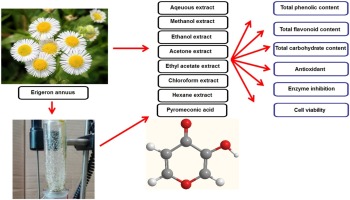Industrial Crops and Products ( IF 5.6 ) Pub Date : 2020-03-03 , DOI: 10.1016/j.indcrop.2020.112283 Luyun Zhang , Qian Xu , Li Li , Lu Lin , Junlin Yu , Junyi Zhu , Hui Zhang , Guangqing Xia , Hao Zang

|
Erigeron annuus (L.) Pers. has been used in folk medicine for the treatment of several diseases. To develop and apply it, we report (for the first time) the antioxidant, enzyme-inhibitory activities, and toxicity of various solvent extracts from Erigeron annuus flower (EAF). The EAF was extracted using seven solvents (water, methanol, ethanol, acetone, ethyl acetate, chloroform, and hexane) to obtain extracts, respectively. The chemical composition of extracts was also determined by spectrophotometric methods (total phenolic content (TPC), total flavonoid content (TFC), total carbohydrate content (TCC), ultraviolet and infrared spectroscopy, high-performance liquid chromatography coupled with electrospray ionization mass spectrometry, and nuclear magnetic resonance spectroscopy. The aqueous extract had the highest TPC and TCC. The methanol extract showed the highest TFC. Pyromeconic acid (PY) was the major component of EAF, which was present in all extracts and was prepared by sublimation. The ethanol extract exhibited the highest content of PY (1.4 %). The methanol extract showed the strongest ability to scavenge 2,2-diphenyl-1-picrylhydrazyl radicals. Acetone extract and PY against 2,2′-azino-bis (3-ethylbenzothiazoline-6-sulphonic acid) diammonium salt cation radicals, and hydroxyl radicals. The methanol extract exhibited the highest antioxidant activity in ferric-reducing antioxidant power, and cupric ion-reducing antioxidant capacity assays. The best chelating activity of ferrous ions was shown in the chloroform extract. Methanol and acetone extracts proffered the highest protection against cellular oxidative damage. Hexane and chloroform extracts had the highest inhibitory activity towards α-glucosidase and α-amylase, respectively. The hexane extract and PY showed high toxicity against HeLa cells. Taken together, these results suggest possible novel applications of EAF as a source of innovative bioactive ingredients for human nutrition and/or phytomedicine.
中文翻译:

从提取物的抗氧化酶抑制活性一年蓬花
rig(Erigeron annuus)已在民间医学中用于治疗多种疾病。为了开发和应用它,我们首次报告了黄E的各种溶剂提取物的抗氧化剂,酶抑制活性和毒性花(EAF)。使用七种溶剂(水,甲醇,乙醇,丙酮,乙酸乙酯,氯仿和己烷)萃取EAF,分别获得萃取液。提取物的化学成分也通过分光光度法测定(总酚含量(TPC),总黄酮含量(TFC),总碳水化合物含量(TCC),紫外和红外光谱,高效液相色谱与电喷雾电离质谱联用,水提取物的TPC和TCC最高,甲醇提取物的TFC最高,吡咯烷酸(PY)是EAF的主要成分,存在于所有提取物中并通过升华制备。提取物表现出最高的PY含量(1.4%)。甲醇提取物表现出最强的清除2,2-二苯基-1-吡啶甲基肼基自由基的能力。丙酮提取物和PY对抗2,2'-叠氮基双(3-乙基苯并噻唑啉-6-磺酸)二铵盐阳离子自由基和羟基自由基。甲醇提取物在还原铁的抗氧化能力和还原铜离子的抗氧化能力分析中表现出最高的抗氧化活性。在氯仿提取物中显示出最佳的亚铁离子螯合活性。甲醇和丙酮提取物对细胞氧化损伤具有最高的保护作用。己烷和氯仿提取物分别对α-葡萄糖苷酶和α-淀粉酶具有最高的抑制活性。己烷提取物和PY对HeLa细胞显示出高毒性。在一起











































 京公网安备 11010802027423号
京公网安备 11010802027423号